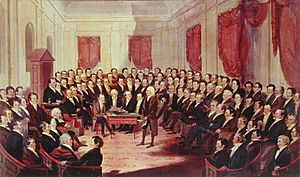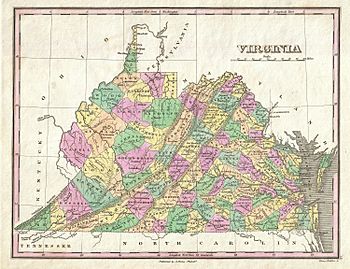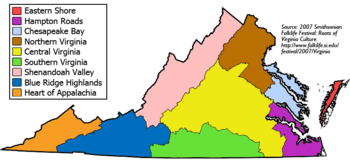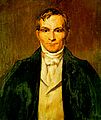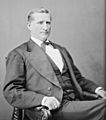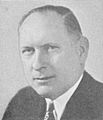Virginia Conventions facts for kids
The Virginia Conventions were special meetings of elected representatives. Their main job was to create or change the basic laws, called constitutions, for the Commonwealth of Virginia. These constitutions covered the land that is now Virginia, West Virginia, and Kentucky. They have been updated over four centuries.
The first Virginia Conventions took over from the British colonial government. They acted on behalf of "the people" until Virginia formed its own state government in 1776. After Virginia joined the United States in 1788, there were five major state conventions. These happened in 1829–30, 1850, 1864 (during the Civil War), 1868, and 1902. These early meetings mostly focused on who could vote and how people were represented in the state's law-making body, the General Assembly. In 1861, as the American Civil War was about to begin, conventions were held in Richmond (for leaving the U.S.) and in Wheeling (for staying loyal to the U.S. Constitution).
In the 1900s, some conventions were held for specific reasons. For example, in 1945, a convention allowed soldiers to vote during wartime. In 1955, another convention dealt with the Supreme Court's order to end segregation in public schools. Instead of conventions, special groups called commissions were sometimes used to suggest changes to the constitution. This happened in 1927 and 1969. All these suggestions from the 1900s were put to a vote by the people.
Contents
- Early Revolutionary Conventions (1774-1775)
- Leaders of Virginia Conventions
- Fifth Revolutionary Convention (1776)
- Virginia Ratifies the U.S. Constitution (1788)
- Constitutional Convention of 1829–1830
- Constitutional Convention of 1850
- Secession Convention of 1861
- Wheeling (Virginia) Convention of 1861
- Constitutional Convention of 1864
- Constitutional Convention of 1868
- Constitutional Convention of 1902
- Twentieth Century Constitutional Changes
- Later Amendments
- Chart of Virginia Conventions
Early Revolutionary Conventions (1774-1775)
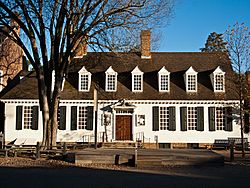
The First Convention started after the British governor, Lord Dunmore, closed down Virginia's elected assembly, the House of Burgesses. This happened because the Burgesses showed support for Boston, Massachusetts, when the British closed its harbor. The Burgesses then moved to Raleigh Tavern to keep meeting. They supported Massachusetts and asked for a meeting of all the colonies, called the Continental Congress.
The First Convention met on August 1, 1774. They elected leaders, stopped trade with Britain, and promised to provide supplies. They chose Peyton Randolph, the Speaker of the House of Burgesses, to lead the convention.
The Second Convention met in Richmond on March 20, 1775, at St. John's Episcopal Church. They again chose a leader and elected representatives for the Continental Congress. At this meeting, Patrick Henry famously gave his "Give me liberty or give me death!" speech. He wanted to arm the Virginia militia (citizen soldiers). The convention decided to prepare for defense and named a committee, including George Washington and Thomas Jefferson, to plan for this.
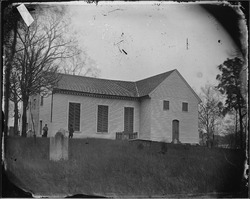
Between conventions, in April 1775, Peyton Randolph talked with Lord Dunmore about gunpowder that had been taken from Williamsburg. The House of Burgesses met one last time in June 1775. They rejected a British peace offer, which the Continental Congress also later turned down.
The Third Convention met on July 17, 1775, also at St. John's Church. Lord Dunmore had left the capital and was on a British warship. Peyton Randolph continued to lead the meeting. The convention created a Committee of Safety to act as the government since the governor was gone. They also divided Virginia into 16 military areas and decided to raise regular troops.
The Fourth Convention met in Williamsburg in December 1775. This was after Lord Dunmore said the colony was in revolt and fighting had begun. Edmund Pendleton became the new leader after Peyton Randolph died. The convention stated that Virginians were ready to defend themselves. They also decided to raise more troops. Even though there was fighting, these first four conventions did not officially declare independence from Britain.
Leaders of Virginia Conventions
-
Peyton Randolph
1774, 1775 -
Philip P. Barbour
1830 -
John Goode, Jr.
1902 -
Harry F. Byrd, Sr.
Governor who called the 1927 Commission
Fifth Revolutionary Convention (1776)
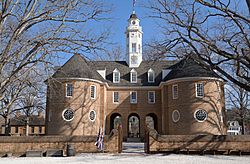
By early 1776, George Washington, a Virginia delegate, was leading the Continental Army around Boston. Virginia soldiers had also defeated a British force near Norfolk.
The Fifth Convention met in Williamsburg from May 6 to July 5, 1776. Edmund Pendleton was chosen to lead it. There were three main groups of delegates. One group was made of wealthy landowners. Another group included thinkers like George Mason and Thomas Jefferson. The third group was younger and more "radical," led by Patrick Henry, who wanted independence sooner.
On May 15, the Convention declared that Virginia's government under King George was "totally dissolved." They passed three important resolutions: one for a Virginia Bill of Rights, one for a republican constitution, and one for alliances with other colonies and foreign countries. They also told their delegates in Philadelphia to declare independence for all colonies.
On June 7, Richard Henry Lee, a Virginia delegate, followed these instructions. He proposed to Congress that "these colonies are, and of right ought to be, free and independent states." This idea was later included in the American Declaration of Independence.
The convention approved George Mason's Virginia Declaration of Rights on June 12. This document was a model for the United States Bill of Rights. On June 29, they approved the first Constitution of Virginia. They also chose Patrick Henry as the first governor of the new Commonwealth of Virginia. So, Virginia had its own working government before July 4, 1776.
Virginia Ratifies the U.S. Constitution (1788)
In 1787, a meeting called the Constitutional Convention created a new plan for the United States government. This plan, the U.S. Constitution, needed to be approved by each state. Virginia's approval was very important because it was a large state that stretched from the Atlantic Ocean to the Mississippi River. If Virginia didn't join, the new nation would be split in two.
The Virginia Ratifying Convention met from June 2–27, 1788, in Richmond. Edmund Pendleton led the meeting. The convention narrowly voted to approve the new U.S. Constitution. James Madison led those who supported it, while Patrick Henry led those who were against it. Governor Edmund Randolph, who had not signed the U.S. Constitution, decided to support it for the sake of national unity. George Mason continued to oppose it because it didn't have a Bill of Rights. Virginia's approval included a suggestion for a Bill of Rights. Madison later helped create the Bill of Rights, which was then sent to the states for approval.
Patrick Henry questioned why the Philadelphia Convention spoke for "We, the people" instead of "We, the states." He thought they should have only suggested changes to the old Articles of Confederation. George Mason worried that a strong national government would make Virginians pay too many taxes. Madison argued that past confederations (loose alliances of states) had failed and led to chaos. He believed a strong government was needed to act directly on individuals.
The Virginia Convention approved the U.S. Constitution by a close vote of 89 to 79. Virginians stated they could leave the new government if its powers were used to harm them. However, they also believed that problems in the Constitution should be fixed by amendments.
Constitutional Convention of 1829–1830
Soon after the 1776 Constitution was created, people saw its problems. It limited who could vote based on property ownership. Also, the way representatives were chosen favored the smaller eastern counties. Many people wanted changes, especially to give more people the right to vote and to make representation fairer.
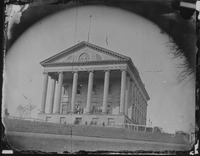
The Convention met from October 5, 1829, to January 15, 1830. Philip Pendleton Barbour was its leader. Many important figures from the Revolutionary era, like former presidents James Madison and James Monroe, and Chief Justice John Marshall, were there. But younger leaders were also present.
People debated how to count the population for representation. Some wanted to count only white people. Others wanted to count white people and a portion of enslaved people. Conservatives worried that changing the constitution would lead to chaos. John Marshall argued that any white man who had served in the War of 1812, or would serve in the militia, deserved the right to vote.
Reformers wanted the governor to be elected directly by the people, but this idea was defeated. They also tried to discuss ending slavery gradually, but this idea didn't even get debated. The reformers lost on most issues. The final vote on the new constitution was 55 for and 40 against. The vote showed a clear split between eastern and western Virginia. Only one delegate from west of the Blue Ridge Mountains voted yes.
Constitutional Convention of 1850
After the 1830 Constitution, Virginia's politics began to change. People in western Virginia wanted fairer representation and more voting rights. They pushed for changes to the constitution.

The delegates at this convention were mostly younger leaders starting their careers. They were different from the older, more established leaders of the 1829–30 convention.
The Convention met from October 14, 1850, to August 1, 1851. John Y. Mason was its leader. There were fierce debates, which were widely reported. People argued about how to elect the governor and how to count the population for representation. Some worried about protecting slavery.
After many months, a compromise was reached on representation. The House of Delegates would be based on the white population, giving western counties more power. But the Senate would be based on a mix of population and property (including enslaved people), giving eastern counties more power. The convention also agreed to let the people directly elect the governor, but each governor could only serve one term. They voted against having public education in the constitution and kept the old system of voting aloud instead of by secret ballot.
Secession Convention of 1861
When Abraham Lincoln was elected president, the country was deeply divided over slavery. Several Southern states decided to leave the United States and form the Confederate States of America. Virginia's state assembly called a special convention to decide if Virginia should also leave the Union. Virginia was very split, with about one-third of the delegates wanting to secede and two-thirds wanting to stay. However, those who wanted to stay were also divided. Some would only stay if Lincoln didn't use force against the Southern states, while others were always loyal to the U.S. government.

The Convention met from February 3 to December 6, 1861. John Janney was its leader. At first, most delegates voted to stay in the Union, but they kept meeting to see what would happen. On March 4, Lincoln's inauguration day, the Confederate president, Jefferson Davis, called up soldiers and surrounded U.S. forts. A delegate from western Virginia, Waitman T. Willey, warned that leaving the Union would lead to war, taxes, and the end of slavery in Virginia.
However, after the U.S. fort, Fort Sumter, was attacked, Lincoln asked states for soldiers to get back federal property. This caused many delegates who had been "Conditional Unionists" to switch sides. They didn't want Virginia to send troops against other Southern states. On April 17, the convention voted 88 to 55 to leave the Union.
Two days after this vote, and a month before the people could vote on it, the Confederate flag was raised over Virginia's capitol. Virginia sent delegates to the Confederate Congress, and a Confederate army was invited to Richmond. Even though some votes were lost, the people approved secession by a large margin.
Wheeling (Virginia) Convention of 1861
Virginia's second Convention in 1861 was a meeting of Union supporters. It was a response to the secession movement. The First Wheeling Convention met in Wheeling (now West Virginia) from May 13–15. They decided to hold another meeting if Virginia voted to secede. After Virginia's secession vote passed, the Second Wheeling Convention met from June 11–25. They created the Restored Government of Virginia and elected Arthur I. Boreman as its leader. A second session of this convention met in August to call for a new state, to be named Kanawha, from Virginia's western territory.
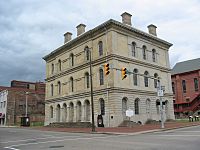
The Second Wheeling Convention included delegates from 32 western counties, plus Alexandria and Fairfax County. Many delegates were already members of Virginia's General Assembly.
John S. Carlile, a strong Union supporter, helped create the Restored Virginia Government. He argued that the U.S. Constitution was the highest law. He said that any state action against the federal government was invalid. On June 17, Carlile called the rebellion "treason." He also described how the Richmond Secession Convention was pressured by angry crowds.
Francis H. Pierpont was elected Governor of the Restored Government of Virginia. Lincoln's government recognized this as the true government of Virginia. By 1863, Union armies couldn't take back most of eastern Virginia. Because of this, West Virginia became its own state.
Constitutional Convention of 1864
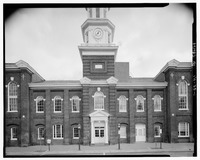
After West Virginia became a separate state, the remaining Restored Virginia government held a convention. Delegates came from a few counties controlled by Union forces. The Convention met in Alexandria from February 13 to April 11, 1864. LeRoy G. Edwards was its leader. The delegates wanted to know if the U.S. government would support their civil authority. They debated whether to prevent all Confederate supporters from voting. However, they decided to only limit voting for those who had held office in the Confederate government.
After much discussion, the Convention decided to end slavery immediately on April 10, 1864. They also changed the voting system from voting aloud to secret ballots. This 1864 Constitution was only enforced in areas under Union control. But it served as Virginia's main law until the 1870 Constitution took effect.
Constitutional Convention of 1868
During the period after the Civil War, called Congressional Reconstruction, U.S. General John Schofield oversaw Virginia. To rejoin the U.S. Congress, Virginia had to include the 14th Amendment in its state constitution. By the time Schofield called a new convention in 1868, three main groups had formed in Virginia. Radical Republicans wanted full political and social equality for Black people. They also wanted to stop former Confederates from voting or holding office. Moderate Unionists wanted equality for Black people but believed former Confederates should be included in politics. Conservatives wanted white control of the state.

The convention met from December 3, 1867, to April 17, 1868, in Richmond. John C. Underwood was its leader. This convention was mostly made up of Radical Republicans. They proposed two controversial rules to limit voting for former Confederates. After talks with President Grant, these two proposals were voted on separately. The rest of the constitution was approved by the people. It gave African Americans the right to vote and created public education.
The convention also discussed the relationship between federal and state governments. They decided that the U.S. Constitution and federal laws were the highest law. They also stated that Virginia would always be part of the United States.
The Radical Republicans wanted to prevent former Confederates from voting. They proposed rules that would deny the vote to anyone who had held office in the Confederate government or had fought against the United States. General Schofield and President Grant worked to have these two rules voted on separately from the rest of the constitution. The main part of the constitution was approved, but these two rules were defeated.
Constitutional Convention of 1902
After Reconstruction ended in the 1870s, Virginia and other Southern states passed Jim Crow laws. These laws limited the rights of Black people, including voting. By 1890, many Southern states held conventions to remove large numbers of white and most Black voters from the registration lists. Some reformers wanted to change the 1868 constitution, which they saw as forced upon Virginians by outsiders.

In May 1900, public concern about voting fraud led to a vote to call a new constitutional convention.
The convention met from June 12, 1901, to June 26, 1902, in Richmond. John Goode, Jr. was its leader. He had been a delegate to the 1861 Secessionist Convention. The convention agreed to limit the voting rights of African Americans and white people who couldn't read or write. They also created a State Corporation Commission to regulate businesses like railroads.
The convention put in place poll taxes (a fee to vote) and tests to check if people could read or understand the constitution. These rules quickly stopped many Black people and about half of the white voters from voting.
Twentieth Century Constitutional Changes
After the 1901–02 convention, Virginia made constitutional changes in the 1900s in different ways. Sometimes, the governor appointed special commissions to suggest changes. Other times, the General Assembly called limited conventions for specific purposes. Unlike the earlier convention, all changes to the Virginia Constitution after 1902 were put to a vote by the people. Women in Virginia gained the right to vote in 1920, after a national amendment was passed.
Constitutional Commission of 1927
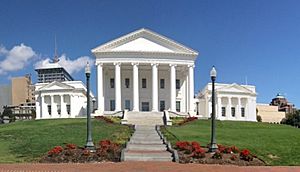
This Commission met from July 7, 1926, to February 16, 1927. Virginia Chief Justice Robert R. Prentis led it. Governor Harry F. Byrd, Sr. wanted to make the government more efficient. He succeeded in making local government simpler and giving the governor more power. The commission also put limits on how much debt the General Assembly could create.
Limited Constitutional Convention of 1933
This convention met and finished its work on October 25, 1933. C. O'Connor Goolrick was its leader. Its only purpose was to approve the 21st Amendment to the U.S. Constitution. This amendment ended Prohibition, which had banned the sale of alcohol. Virginia was one of the states that quickly approved this amendment.
Limited Constitutional Convention of 1945
This convention met on April 30 and May 1, 2, and 22, 1945. John J. Wicker, Jr. was its leader. During World War II, this convention was called for one specific reason: to allow members of the armed forces to vote while they were serving. Some delegates tried to expand the convention's purpose to lower the voting age below 21, but this failed.
Limited Constitutional Convention of 1956
This convention met from March 5–7, 1956. John C. Parker was its leader. The U.S. Supreme Court had ruled that segregated public schools were unconstitutional. In response, supporters of "massive resistance" (a plan to oppose school integration) held this convention. Its goal was to allow state money to be used for private schools, which would then be segregated.
Constitutional Commission of 1969
This Commission met from April 1968 to January 1, 1969. Former Governor Albertis S. Harrison, Jr. was its leader. After many years, Governor Mills E. Godwin, Jr. called this commission. Its job was to combine many small changes into one clear constitution. It also made sure the state constitution followed U.S. laws, especially concerning education, voting rights, and how voting districts were drawn.
Later Amendments
After the 1901–02 Convention, Virginia's General Assembly did not call another large convention in the 1900s. Since the 1960s, some proposed changes to the constitution have not passed, but they are still discussed. Virginia is the only state that prevents governors from serving two terms in a row. It is also one of only two states where the state legislature chooses judges.
Since 1971, more changes have been added to the constitution because of federal laws. For example, amendments lowered the voting age to eighteen, removed residency rules for voting, and made voter registration easier. Virginia also joined other states in 1996 by adding rights for crime victims to its constitution. Later, a provision was added to protect the right to hunt, fish, and harvest game.
In 2006, Virginians voted to add an amendment to ban marriage between people of the same sex. This amendment stated that marriage was only "unions between one man and one woman." However, in 2015, the U.S. Supreme Court ruled in Obergefell v. Hodges that the U.S. Constitution protects the right to marry for all couples.
Chart of Virginia Conventions
| Convention/Commission | Dates | Place | Presiding officer | Reason for meeting | What happened |
|---|---|---|---|---|---|
| First Revolutionary convention | August 1, 1774 | Williamsburg | Peyton Randolph | Governor closed the House of Burgesses | Called for a Continental Congress |
| Second Revolutionary convention | March 20, 1775 | Richmond | Peyton Randolph | Needed a safe place to meet | Decided to arm the militia |
| Third Revolutionary convention | July 17, 1775 | Richmond | Peyton Randolph | Governor (Dunmore) left Williamsburg | Created the Committee of Safety |
| Fourth Revolutionary Convention | December 1775 | Williamsburg | Edmund Pendleton | Needed safety in Williamsburg | Raised more troops |
| Constitutional Conventions | |||||
| Fifth Revolutionary Convention | May 6 - July 5, 1776 | Williamsburg | Edmund Pendleton | Moving towards independence | Created a republican constitution |
| Ratifying (Federal) Convention | June 2–27, 1788 | Richmond | Edmund Pendleton | To approve the U.S. Constitution | Virginia approved the U.S. Constitution |
| Constitutional Convention of 1829–30 | October 5, 1829 - January 1830 | Richmond | Philip P. Barbour | Unfair representation in government | Traditional ways mostly stayed |
| Constitutional Convention of 1850 | October 14, 1850 - August 1, 1851 | Richmond | John Y. Mason | Unfair representation in government | Governor elected by popular vote |
| Secession Convention of 1861 | February 3 - December 16, 1861 | Richmond | John Janney | To decide on leaving the U.S. | Voted to secede (leave the Union) |
| Wheeling (Virginia) Convention of 1861 | May 13–15, 1861 | Wheeling | Arthur I. Boreman | Response to secession | Formed a Restored Government loyal to the U.S. |
| Loyalist Convention of 1864 | February 13 - April 11, 1864 | Alexandria | LeRoy G. Edwards | West Virginia became a state | Slavery was abolished |
| Constitutional Convention of 1868 | December 3, 1867 - April 17, 1868 | Richmond | John C. Underwood | To approve the 14th Amendment | African Americans gained voting rights |
| Constitutional Convention of 1902 | June 12, 1901 - June 26, 1902 | Richmond | John Goode, Jr. | To reform politics | Many white and Black voters lost voting rights |
| 20th century activity | |||||
| Constitutional Commission of 1927 | July 7, 1926 - February 16, 1927 | Richmond | Robert R. Prentis | To make government more efficient | Governor gained more power |
| Limited Constitutional Convention of 1933 | October 25, 1933 | Richmond | C. O'Connor Goolrick | To end Prohibition | Prohibition ended in Virginia |
| Limited Constitutional Convention of 1945 | April 30 - May 1,2,22, 1945 | Richmond | John J. Wicker, Jr. | To allow soldiers to vote | Servicemen gained voting rights |
| Limited Constitutional Convention of 1956 | March 5–7, 1956 | Richmond | John C. Parker | Response to school desegregation | Allowed public money for segregated private schools |
| Constitutional Commission of 1969 | April 1968 - January 1, 1969 | Richmond | Albertis S. Harrison, Jr. | To update the constitution | Constitution updated to match U.S. laws |


